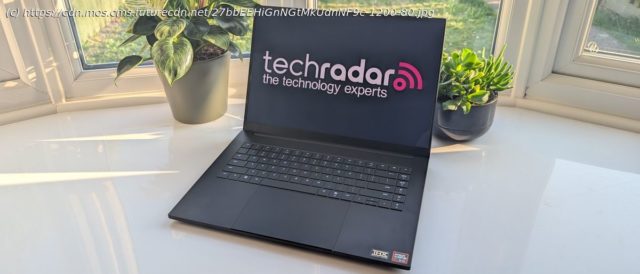RTX 5000 has landed in gaming laptops. if you can afford it
Razer Blade 16 (2025): Two minute review
Weeks of stock shortages and scalping later, I can finally breathe: RTX 5000 laptops are here, offering a fresh path into Nvidia’s glorious ray-traced future that doesn’t involve selling your soul on Ebay – though you might need to sell a kidney to afford the new Razer Blade 16, especially if you’re eyeing the top-of-the-line RTX 5090 configuration graciously provided to me for this review.
Yes, Razer is not beating the ‘pricey hardware’ allegations any time soon; the new Blade 16 starts at a wallet-battering $2,999.99 / £2,699.99 / AU$4,899.95, and the higher-spec configurations rocket beyond the four-thousand mark in the US, UK, and Europe.
Don’t get me wrong, though: the sky-high pricing is just about the only criticism I have here. Razer’s iconic 16-inch laptop has undergone a subtle redesign – and I mean subtle, bordering on indistinguishable – that provides a range of small but worthy improvements, and at the heart of it all, Nvidia’s Blackwell GPU lineup delivers boosted performance and a new wealth of features ready to do battle with the best gaming laptops.
I’ll get into the real meat of these graphics upgrades later on, but here’s the short version: this thing goes hard. Between DLSS 4, Multi Frame Generation, Reflex 2, and the general generational improvements from RTX 4000, even the most demanding titles deliver crisp, speedy frame rates on the QHD+ OLED screen – and the 240Hz refresh rate means you won’t find your game performance capped by the display.
The Razer Blade 16 isn’t all steak and no sizzle, either. This is one classy-looking gaming laptop, as I’ve come to expect from Razer, with an anodized aluminum chassis, per-key RGB lighting, and the same overall top-notch build quality any previous Razer owner will be well accustomed to. Again, scroll on down to that Design section for all the juicy deets, but I will take a quick moment here to remark on the new-and-improved keyboard, which now features greater key travel and smoother actuation than previous models to provide a more pleasant typing experience as well as responsive inputs when gaming.
With how difficult it’s proving to get your hands on a desktop RTX 5000 GPU, many will be looking towards the incoming slate of Blackwell-equipped laptops to scratch that hardware upgrade itch. If that’s you – and you can stomach the price tag – then the Razer Blade 16 is the laptop to pick.Razer Blade 16 (2025): Price and availability
How much is it? Starting at $2,999.99 / £2,699.99 / AU$4,899.95
When is it available? Available now
Where can you get it? Available in the US, UK, and Australia
There’s no getting around it: this is one expensive laptop, even pricier than the previous RTX 4000 Razer Blade 16 we reviewed back in late 2023. Granted, you’re getting a hell of a lot of gaming power for your money, but it’s still pricey.
The Razer Blade 16 (2025) will cost you $2,999.99 / £2,699.99 / AU$4,899.95 for the base configuration: that gets you an RTX 5070 Ti, 10-core AMD Ryzen AI 9 HX 365 processor, 32GB of ultra-speedy LPDDR5X 8,000MHz memory, and a 1TB SSD. That’s right – the long-standing industry baseline of 16GB of RAM is out, 32GB is the new standard for Razer.
There are a few different configurations, with more RAM or storage and an upgrade to either an RTX 5080 or 5090. The top-spec model costs a piggy-bank-busting $4,899.99 / £4,299.99 / AU$7,999.95, packing the RTX 5090 along with a 12-core Ryzen AI 9 HX 370 CPU, 64GB of RAM, and a huge 4TB of storage (in the form of two 2TB SSDs). Every version has the same 16-inch 240Hz QHD+ OLED display; sadly, there’s no 4K model on offer, which does feel like a somewhat odd omission considering that the RTX 5090 is absolutely capable of 4K gaming.
I really can’t stress enough that this is a comically enormous amount of money for the average PC gamer. As a fun little exercise, I went looking online for used cars that cost less than the Blade 16 review unit I’m typing this review on. 47,764 results. Oof.
Still, when scalpers are selling RTX 5090 cards on Ebay for upwards of four thousand bucks, it’s not an entirely unattractive proposition. I mean, you’re getting the whole system here, while the additional cost of a full desktop PC build capable of supporting Nvidia’s latest flagship GPU without bottlenecking isn’t exactly cheap. I have no doubt there will be laptops from other manufacturers that offer the same (or at least similar) specs at a lower price, but there will be sacrifices made – whether that’s chassis materials, display quality, or memory speed.
Value: 2.5 / 5Razer Blade 16 (2025): SpecsRazer Blade 16 (2025): Design
Same classic Blade finish with premium-feel anodized metal casing
New keyboard design is a real improvement
Chassis is lighter and more compact than previous models
Razer has long held a reputation as a company known for using premium materials for its hardware, and the new Blade 16 certainly doesn’t buck this trend: every Blade begins life as a singular slab of tempered aluminum, which is then precision-milled into shape and electrochemically anodized to create a wear-resistant color finish designed to last.
Although the overall aesthetic of Razer’s modern Blade lineup has changed very little over the years – compare this laptop side-by-side with the Razer Blade we reviewed back in 2018, and you’ll see what I mean – there have been some small adjustments this time around, and all of them are good changes.
For starters, the laptop has been retooled to reduce the overall weight and size; there’s a limit to this, especially with a 16-inch display, but Razer has managed to cut down the total package volume by almost 30%. It’s almost half a centimetre thinner than the previous-gen Blade 16 (4.59mm, to be precise), and it adds that half-centimete to the length of the laptop instead – in practice, this doesn’t make the Blade 16’s footprint any appreciably larger, but does make it look and feel a lot thinner.
Home
United States
USA — software I've reviewed dozens of gaming laptops, and the new Razer Blade 16...






